![]() 1st Battalion 22nd Infantry
1st Battalion 22nd Infantry ![]()
Donald N. Lee
Company B and Company D
The Army Service of Donald N. Lee
Donald Norman Lee was born in Minneapolis, Hennepin County, Minnesota on July 25, 1918.
In later years he described his
youth as "he was poor but so was everyone else so you really
didn't think about it.
When he went into the military he had one nickel in his
pocket." His mother was a widow who did her best as a
single Mom to raise and care for her son.
Lee graduated from West High
School in Minneapolis in 1937. As a youth he and his friends
would drive their
"jalopies" on Mount Curve Avenue in Minneapolis. From
April 1938 to January 1941 he worked at Berry Chase
Company in Minneapolis as a sales person where he displayed,
stocked, shipped and sold retail electrical
merchandise and did some simple record keeping.
Lee entered the Army on February
17, 1941 at Fort Snelling, Minnesota and served as an enlisted
man in
Company I 3rd Battalion 20th Infantry 6th Division. In May 1941
all units of the 6th Division assembled at
Fort Leonard Wood, Missouri which would be Lee's home for the
next year and a half.
His military occupational
specialty was truck driver, which he was assigned on April 1,
1941. Lee was promoted
to Corporal on June 14, 1941 and took part with his unit in the
Louisiana Maneuvers held in 1941. He was promoted
to Sergeant on October 15, 1941.
Lee attended Officer Candidate
Course at the Infantry School at Fort Benning, Georgia from
September 13
to December 9, 1942 and upon graduation was commissioned a 2nd
Lieutenant of Infantry in the
Officers Reserve Corps, Army of the United States (AUS).
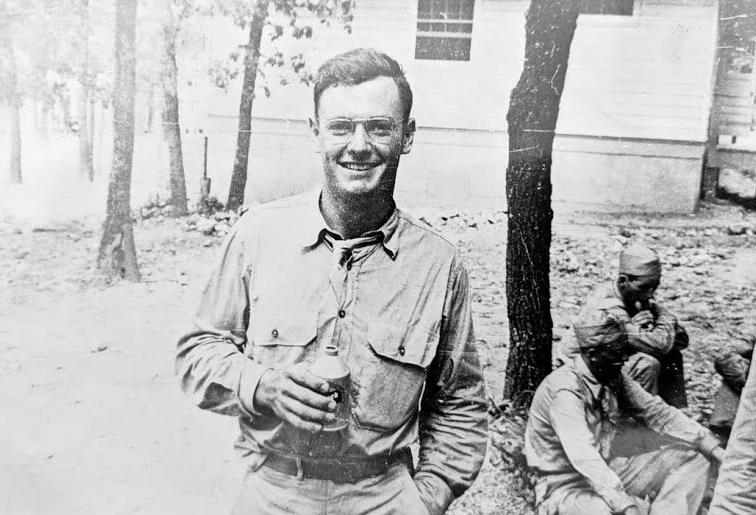
Donald N. Lee as an enlisted man 1941, location unrecorded.
Right: Spring, 1942 Fort Leonard Wood, Missouri Three soldiers of Company I Left to right: Bob Klenert, Don Lee, Klenert and Lee left the Klenert went to the 12th
Infantry |
|
|
Left: Donald N. Lee as a Sergeant He is wearing the Distinctive
Unit Insignia |
Right: The Graduation Program September 13 - December 9, 1942 Fort Benning, Georgia |
|
|
Left: Certificate of Graduation for |

Identification card for
2nd Lieutenant Donald N. Lee dated January 12, 1943.
His birth date is incorrect on the card.
As a brand new officer Lee was
assigned to Company B 1st Battalion 22nd Infantry 4th Motorized
Division
at Camp Gordon, Georgia. (The 4th Infantry Division was the
testbed as the Army's first mechanized or
"motorized" Division from 1940 until 1943 and was
called the 4th Motorized Division beginning in June 1940
until it was again redesignated as the 4th Infantry Division in
middle to late 1943.)
In 22nd Infantry Headquarters
General Orders No. 5 issued at Fort Dix, New Jersey on June 8,
1943
Lee was awarded the Good Conduct Medal for his previous service
as an enlisted man. He took
amphibious training with the 22nd Infantry at Camp Gordon
Johnston, Florida
and shipped over to England with his Regiment aboard the Capetown
Castle in January 1944.
After further training in England based out of Newton Abbott,
Devon he assembled with his
Company and Regiment in the marshalling area on May 18 and
prepared for the invasion of Europe.
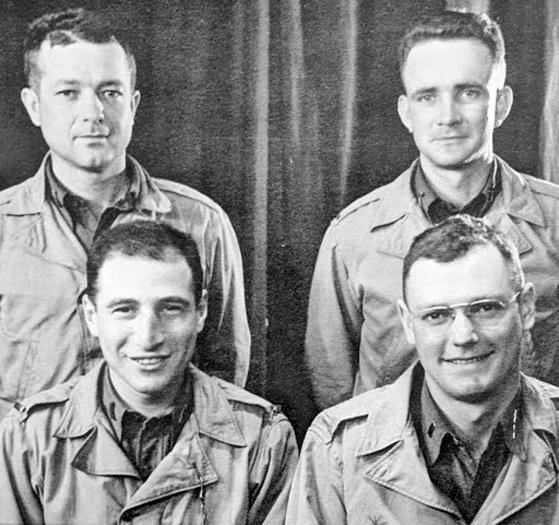
Four Lieutenants from
Company B 22nd Infantry prior to the D-Day landing.
Back row left, Dave Davis - right, Quentin Surratt
Front row left, Abby Abkowitz - right, Donald Lee
Davis, Abkowitz and Lee would all be wounded in action. Surratt would be killed in action.
On D-Day June 6, 1944 Lee and
Company B approached the French coast after crossing the English
Channel
in LCI 320 (Landing Craft Infantry). They landed on Utah Beach
about two hours behind the first wave.
Making the landing also in
Company B were 2nd Lieutenant Rufus L. Ware and 2nd Lieutenant
Bernard C. Sheehy, both of whom were with Lee in the 22nd
Infantry at Fort Dix
and Camp Gordon Johnston and both of whom like Lee had previously
been enlisted men
prior to becoming officers. After the landing Company B spent
most of D-Day trudging through
the inundated areas behind and along the coast which the Germans
had flooded
to impede the progress of any Allied landing force.
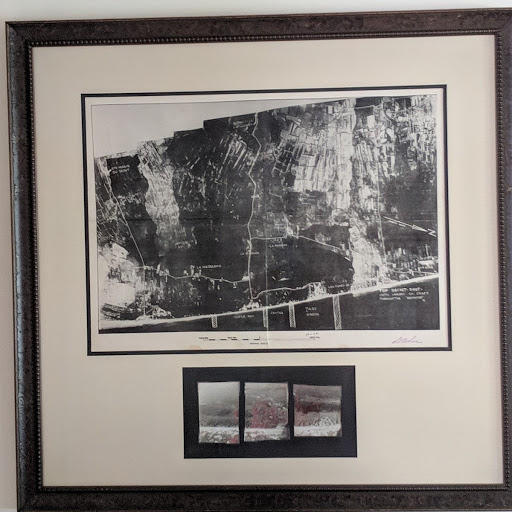
Framed aerial photomap of Utah Beach invasion area which Donald Lee kept among his mementos after the war.
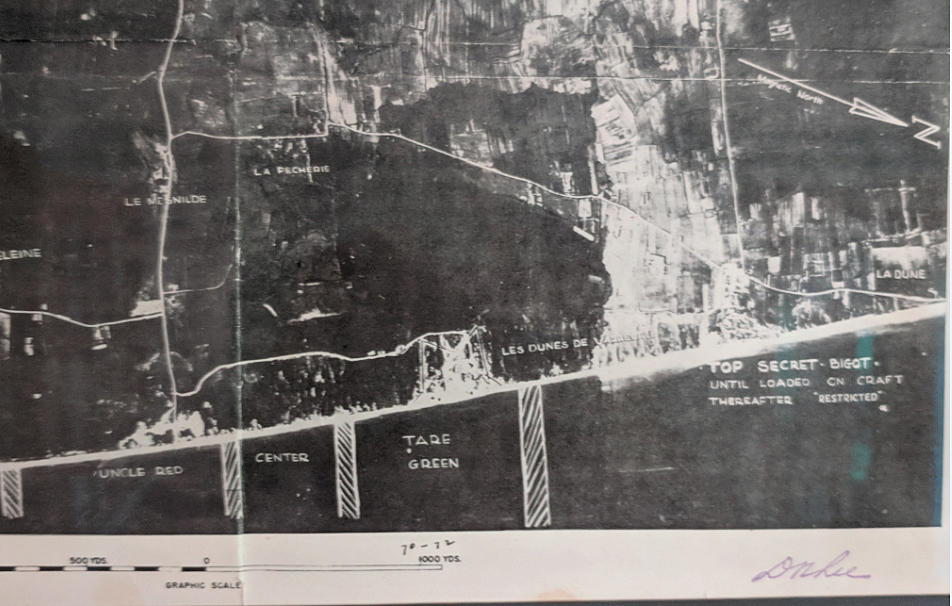
Donald N. Lee's personal copy of the map of the Utah Beach invasion area which has his signature in the lower right corner.
The map is labled
"BIGOT" which was a security classification above Top
Secret. The 22nd Infantry landing area was
scheduled on the beach marked as TARE GREEN. On D-Day the first
elements of the invasion force mistakenly landed
some 2000 yards to the left of the planned area and all
subsequent landings were made at that point as well.
The next day June 7 Lee and his
Company were part of 1st Battalion's attack through the village
of
St. Marcouf and against the German coastal battery at Crisbecq.
On this day Lee received his first Purple Heart
due to enemy mortar fire. One mortar round knocked his helmet
off. He got his helmet back on just in time
as another mortar shell flung shrapnel at him and while some of
it banged off his helmet some also
wounded him in the head. He was pulled out of action temporarily
and attended to by medics
who bandaged his wounds and then returned him to the front lines.
His helmet had saved his life
and he continued to wear the dented and scarred helmet for good
luck during the next few days as he
participated in 1st Battalion's attacks against the enemy
positions at Fontenay-sur-Mer and Dangueville.
On June 12 Lee and his Company
were on the right flank of 2nd Battalion as it attacked the
village
of Ozeville. Lee was knocked down and thrown around by the blast
of six German nebelwerfer
rockets (called "screaming meemies" by the American
G.I.'s because of the sound the
rockets made.) After determining he wasn't hit Lee crossed a
hedgerow and encountered
Lieutenant Rufus Ware. Lee told Ware about being knocked around
by the rockets and a
couple of minutes later enemy mortar rounds impacted in the trees
near them and the area all around them.
Both men were hit by shrapnel. With both of his arms torn and
bleeding Lee touched Ware to see if he was okay
and found Ware was unconscious. Lee could see that Ware had a
critical head wound where shrapnel
had penetrated his steel helmet. A medic came to their aid and
bandaged Lee up behind the hedgerow.
Ware would be listed as killed in action only to be later
discovered to still be alive upon which he was sent
to hospital in England.
|
Left: Notepaper given to Donald N.
Lee The medic has indicated that a
tourniquet The tourniquet had to be
loosened after a Donald Lee kept this paper as
one of his |
Lee's bicep in his left arm was
severed and his right hand was seriously ripped by shrapnel as
well.
After being bandaged Lee was told to go to the aid station. As he
proceeded to walk to the
rear he met a surgeon who noticed Lee was bleeding through his
bandages rather badly.
With a great deal of difficulty the surgeon sewed up Lee's
punctured artery on the spot.
Repairing Lee's artery away from an operating table without
general anesthesia must have
presented both the surgeon and Lee with an experience they never
forgot.
The doctor loaded Lee into his
jeep and drove him to the aid station. Lee's arm was set in a
cast and his wounds
were so serious he was sent by boat across the channel to England
where he was admitted to an Army hospital
for care and recovery. For his wounds of June 12 Donald N. Lee
would be awarded his second Purple Heart.

2nd Lieutenant Donald N.
Lee after being wounded on June 12, 1944.
Photo taken in England while he was recovering from his wounds.
After several months of recovery
in England Lee was sent back across the English Channel to rejoin
his unit.
On the boat going over to France Lee was quite ill and someone
noticed the pallor of his skin and a distinct yellow
color to his eyes. Upon examination it was determined that Lee
had developed jaundice and hepatitis, most likely
from some of the many blood transfusions he had needed during the
treatment for his wounds. He was again
placed in hospital and it would be six more weeks before he was
certified able to return to duty.
Lee rejoined the 22nd Infantry
just as it moved into the Hürtgen Forest of Germany. He was
assigned to Company D
which was in need of a platoon leader. The Hürtgen Forest
produced a huge amount of casualties in the 22nd Infantry.
Lee himself described the forest: " It was dark and gloomy
and the tree bursts hit those firs and everything would come
raining down. The roads were rivers of mud."
In the Hürtgen Forest on
November 15, 1944 Lee was wounded a third time. German artillery
exploded in the trees above him
and shrapnel came flying down causing deep puncture wounds which
once again sent him to a hospital.
He earned his third Purple Heart that day.
Lee was in a hospital in France
until he rejoined his Regiment in Germany on April 3, 1945. On
the day of his return
his good friend William Quentin Surratt was killed in action near
the village of Bad Mergentheim. Lee and Surratt had landed
on D-Day together in Company B and his friend's death struck him
hard.
Lee commanded a platoon in
Company D as the 22nd Infantry moved across Germany through the
towns and villages of
Weikersheim, Ober Rimbach, Weiler, Rote See and Beuerlbach and on
April 20, 1945 entered the outskirts of Crailsheim.
As 1st Battalion approached Crailsheim 2nd Lieutenant Walter E.
Jones of Company C was sent forward with two enlisted men
to make contact with the mayor of the town and arrange for the
town to surrender to avoid its possible destruction. Terms of
surrender had apparently been agreed upon when all three men were
shot by the Germans as they left the scene with Jones
being killed. Donald Lee carried Jones' issue .45 caliber auto
pistol for the rest of the war in addition to the M-1 carbine
(serial number 4279759) and the issue .45 caliber auto pistol
(serial number 2006128) he normally carried.
Lee's letters home mostly showed
his caring nature and consideration for family and friends at
home but sometimes included
short glimpses of life in the combat zone. A passage in one of
his letters showed his sense of humor in dealing with the
dangerous
existence of pushing the Germans further back into their own
territory:
"One good thing was that
Jerry apparently had orders to avoid shelling their towns if
possible so while sometimes they laid artillery
around the small towns they very rarely threw it right into town.
Although one morning I was resting in the shadow of a church
drinking my coffee after a ten mile march before breakfast. Two
rounds of fast stuff hit the church steeple. Scared --- I almost
spilled my precious coffee moving to another building,"
As they moved across Germany the
22nd Infantry used buildings and houses as quarters for the
soldiers, with enlisted men
and officers living in separate places. In another letter dated
May 6, 1945 Lee spoke of how he spent most of his time
with the soldiers of his platoon in their enlisted quarters
instead of staying in the officers quarters. He also related that
on one occasion he was eating in the officers' mess when the wife
of Ernest Hemingway stopped in to have supper
with his Colonel. The wife he spoke about was Martha Gellhorn.
Lee described her thus:
"She's an attractive blond
and a fascinating talker. She had been with the Russians at
Torgau on the Elbe and her
opinions and comments were intensely interesting."
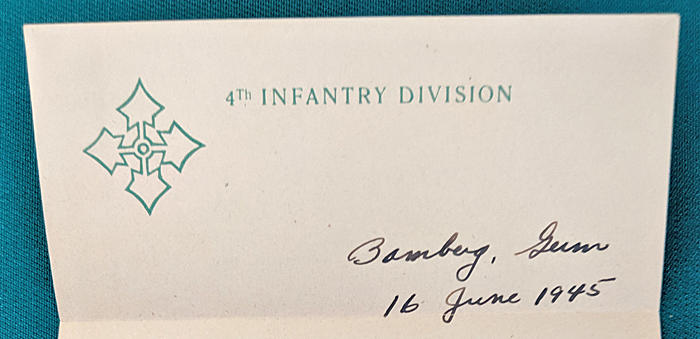
Above: Letterhead of 4th
Infantry Division stationery used by Donald N. Lee
to write some of his letters home. This one was written while he
was in
Bamberg, Germany in June 1945.
In a letter he wrote home a
month after the war ended in Europe Lee remarked how he spent the
day on which the war ended
in Europe, also known as VE day (Victory in Europe day) and in
doing so gave a personal description of how he felt while
leading his men under fire during the assault across Germany ...
when they were moving out into the open and anticipating
being fired upon by the enemy. Lee wrote:
" I didn't do much VE day
except relax. It was a wonderful feeling to be able to debouch
from a town onto open ground
and not have to sweat out that first round coming into your
bunch. That's the worst sensation that of waiting,
once things start to pop you figure 'Here we go again !' "
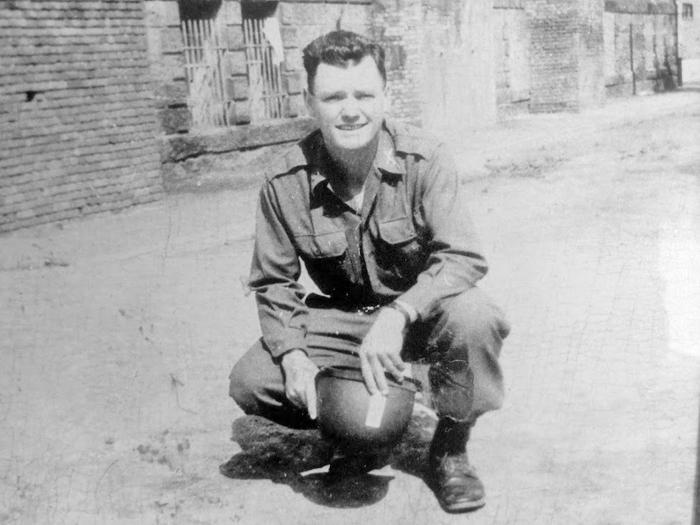
Donald N. Lee in Ansbach, Germany June 1945
On May 17, 1945 Donald N. Lee was promoted to 1st Lieutenant.
Lee served on occupation duty in
Germany with the 22nd Infantry in the Ansbach - Nürnberg area.
His letters home spoke of how impressed he was with the beauty
and charm of the German countryside.
He sailed home with the 22nd
Infantry aboard the U.S. Army Transport James Parker in July
1945.
Lee was one of the few line officers in the 22nd Infantry who
went over to England in January 1944
with the Regiment and returned with it to the United States in
July 1945.
|
Left: Special edition of the 22nd
Infantry The returning soldier is
walking down In the top left is the
Distinctive Unit Insignia At the bottom is the shoulder
sleeve insignia |
Lee served with Company D at
Camp Butner, North Carolina for the rest of 1945. On December 14,
1945
he was separated from active duty at Camp Butner. A little over
two months later the 22nd Infantry was de-activated.
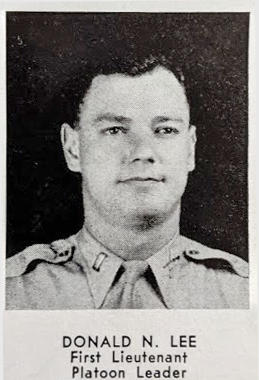
Photo of Donald N. Lee
in the yearbook for the 22nd Infantry
published in 1946 at Camp Butner, North Carolina.
Home | Photos | Battles & History | Current |
Rosters & Reports | Medal of Honor | Killed
in Action |
Personnel Locator | Commanders | Station
List | Campaigns |
Honors | Insignia & Memorabilia | 4-42
Artillery | Taps |
What's New | Editorial | Links |